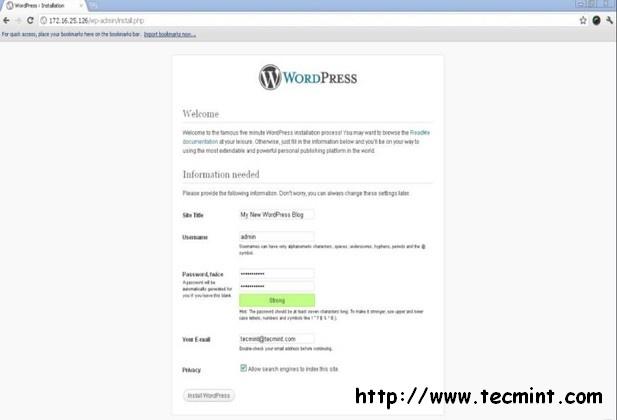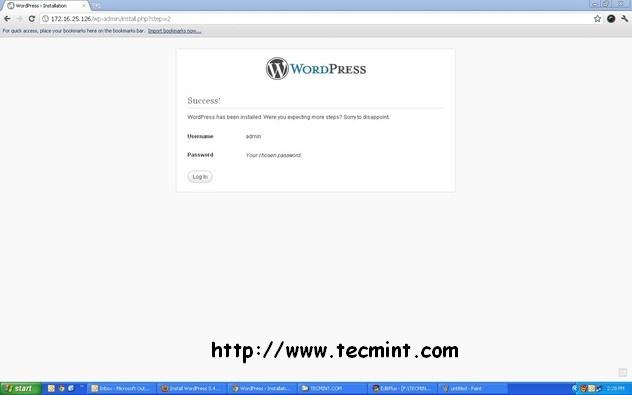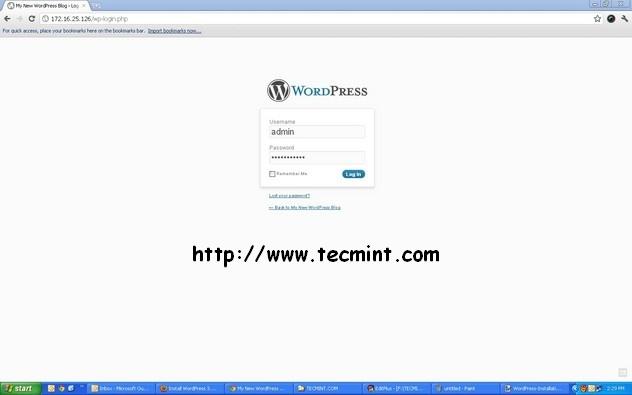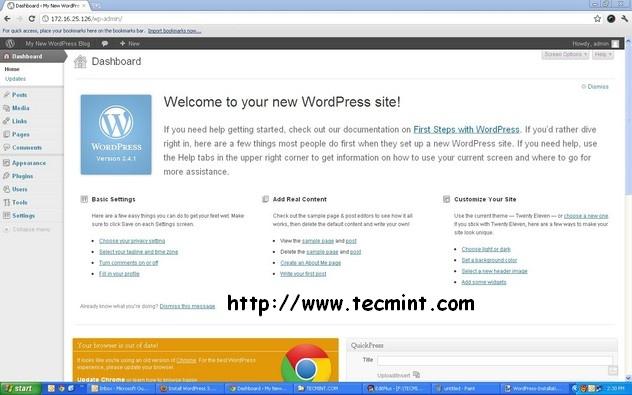Well, on the internet you will find a number of good and better ways to install WordPress on Linux, but this installation guide is prepared for my future reference as well as for those beginners who are new toWordPressandLinuxplatform. In this installation I will show you’ll how to install latestWordPress 3.6.1onRHEL 6.4/6.3/6.2/6.1/6/5.8,CentOS 6.4/6.3/6.2/6.1/6/5.8andFedora 19,18,17,16,15,14,13,12distributions.
This guide has two way of installation, one is usingLAMP(Linux, Apache, MySQL, PHP) and other isLEMP(Linux, Nginx, MySQL, PHP). So, please select your installation method based on your web servers. Before moving ahead let me provide you a little description aboutWordPress,LAMP&LEMP.
What Is WordPress?
WordPressis an open source and free blogging application and a dynamic CMS (Content Management System) developed usingMySQLandPHP. It has huge number of third party plugins and themes. WordPress currently one of the most popular blogging platform available on the internet and used by millions of people across the globe.
What Is LAMP and LEMP?
LAMP (Linux, Apache, MySQL, PHP) and LEMP (Linux, Nginx, MySQL, PHP) is an open source Web application platform that runs on Linux systems. Apache and Nginx both are Web servers, MySQL is RDMS (Relational Database Management System) and PHP is a server side scripting language.
As I said above the installation method has two ways, one is usingApacheand other isNginx. So I have named itAandB. Those who want to installWordPresson theirApacheserver they can useAmethod and those who want to installWordPressusingNginxthey can follow methodB. In case, if you don’t haveLAMPorLEMPsetup on your systems, please use the following guides to install it.
- LAMP (Linux, Apache, MySQL, PHP) setup on RHEL, CentOS & Fedora
- LEMP (Linux, Nginx, MySQL, PHP) setup on RHEL, CentOS & Fedora
Method A: Installing WordPress 3.6.1 for Apache on RHEL, CentOS & Fedora
ThisMethod Ainstallation guide shows you how to install latestWordPress 3.6.1usingLAMPsetup onRHEL 6.4/6.3/6.2/6.1/6/5.8,CentOS 6.4/6.3/6.2/6.1/6/5.8andFedora 19,18,17,16,15,14,13,12.
Step 1: Downloading WordPress 3.6.1 for Apache
You must be root user to download the package.
# cd /tmp
# wget http://wordpress.org/latest.tar.gz
Step 2: Extracting WordPress 3.6.1 for Apache
Once the download finishes, run the following command to untar it.
# tar -xvzf latest.tar.gz -C /var/www/html
Step 3: Creating MySQL Database WordPress
Connect toMySQLserver and run the following commands to create database and grant privileges.
## Connect to MySQL Server & Enter Password (if any or leave blank)##
mysql -u root -p
Enter password:
## Creating New User for WordPress Database ##
CREATE USER wordpress@localhost IDENTIFIED BY "your_password_here";
## Create New Database ##
create database wordpress;
## Grant Privileges to Database ##
GRANT ALL ON wordpress.* TO wordpress@localhost;
## FLUSH privileges ##
FLUSH PRIVILEGES;
## Exit ##
exit
Please replace text a shown inRedcolor with your appropriateDatabase Name,UserandPassword. These settings we will required later.
Step 4: Creating Apache VirtualHost for WordPress
Open the file/etc/httpd/conf/httpd.confwithVIeditor.
# vi /etc/httpd/conf/httpd.conf
Add the following lines of code at the bottom of the file. Replace the text shown inRedcolor with your required settings.
<VirtualHost *:80>
ServerAdmin tecmint@tecmint.com
DocumentRoot /var/www/html/wordpress
ServerName wordpress
ErrorLog /var/log/httpd/wordpress-error-log
CustomLog /var/log/httpd/wordpress-acces-log common
</VirtualHost>
Next, restart theApacheservice to reflect changes.
# service httpd restart
Add the following line to/etc/hostsfile.
127.0.0.1 wordpress
Step 5: Configuring WordPress Installation
Copy defaultwp-config-sample.phptowp-config.phpto configure WordPress installation.
# cd /var/www/html/wordpress
# cp wp-config-sample.php wp-config.php
Openwp-config.phpfile.
# vi wp-config.php
Modify the following database settings as we created in theStep #3above.
// ** MySQL settings - You can get this info from your web host ** //
/** The name of the database for WordPress */
define('DB_NAME', 'database_name_here');
/** MySQL database username */
define('DB_USER', 'username_here');
/** MySQL database password */
define('DB_PASSWORD', 'password_here');
/** MySQL hostname */
define('DB_HOST', 'localhost');
/** Database Charset to use in creating database tables. */
define('DB_CHARSET', 'utf8');
/** The Database Collate type. Don't change this if in doubt. */
define('DB_COLLATE', '');
Step 6: Finishing WordPress Installation
Open your browser and type any of the following address.
http://wordpress/
http://localhost
http://your-ip
Give yourSite Title,Create Admin User,Create Admin Password,Enter Your E-Mailand then click onInstallbutton.
Login into your WordPress Dashboard.
Enter your WordPress Login details.
Welcome to WordPress Dashboard.
View your New WordPress blog.
Method B: Installing WordPress 3.6.1 for Nginx on RHEL, CentOS & Fedora
Step 1: Creating WordPress Directories for Nginx
# mkdir -p /srv/www/wordpress/public_html
# mkdir /srv/www/wordpress/logs
# chown -R nginx:nginx /srv/www/wordpress
Step 2: Downloading and Extracting WordPress 3.6.1 for Nginx
cd /tmp
# wget http://wordpress.org/latest.tar.gz
# tar -xvzf latest.tar.gz -C /srv/www/wordpress/public_html --strip-components=1
Step 3: Creating MySQL Database WordPress
Connect toMySQLserver and run the following commands to create database and grant privileges.
## Connect to MySQL Server & Enter Password (if any or leave blank)##
mysql -u root -p
Enter password:
## Creating New User for WordPress Database ##
CREATE USER wordpress@localhost IDENTIFIED BY "your_password_here";
## Create New Database ##
create database wordpress;
## Grant Privileges to Database ##
GRANT ALL ON wordpress.* TO wordpress@localhost;
## FLUSH privileges ##
FLUSH PRIVILEGES;
## Exit ##
exit
Please replace text a shown inRedcolor with your appropriateDatabase Name,UserandPassword. These settings we will required later.
Step 4: Creating Nginx VirtualHost For WordPress
If you’ve followed ourLEMPguide these directories are already created. In case, if not then please create it by running these commands.
# mkdir /etc/nginx/sites-available
# mkdir /etc/nginx/sites-enabled
Add the following line of code to/etc/nginx/nginx.conffile,Afterthe line that says “include /etc/nginx/conf.d/*.conf.
include /etc/nginx/sites-enabled/*;
Next create Nginx virtualhost file for WordPress.
# vi /etc/nginx/sites-available/wordpress
Add the following content to/etc/nginx/sites-available/wordpressfile.
server {
server_name wordpress;
access_log /srv/www/wordpress/logs/access.log;
error_log /srv/www/wordpress/logs/error.log;
root /srv/www/wordpress/public_html;
location / {
index index.php;
}
# Disable favicon.ico logging
location = /favicon.ico {
log_not_found off;
access_log off;
}
# Allow robots and disable logging
location = /robots.txt {
allow all;
log_not_found off;
access_log off;
}
# Enable permalink structures
if (!-e $request_filename) {
rewrite . /index.php last;
}
# Handle php requests
location ~ \.php$ {
include /etc/nginx/fastcgi_params;
fastcgi_pass 127.0.0.1:9000;
fastcgi_index index.php;
fastcgi_param SCRIPT_FILENAME /srv/www/wordpress/public_html$fastcgi_script_name;
}
# Disable static content logging and set cache time to max
location ~* \.(js|css|png|jpg|jpeg|gif|ico)$ {
expires max;
log_not_found off;
}
# Deny access to htaccess and htpasswd files
location ~ /\.ht {
deny all;
}
}
Create symlink for sites enabled directory.
# cd /etc/nginx/sites-enabled/
# ln -s /etc/nginx/sites-available/wordpress
Restart the Nginx server to reflect changes.
# service nginx restart
Add the following line to/etc/hostsfile.
127.0.0.1 wordpress
Step 5: Configuring WordPress Installation
Copy defaultwp-config-sample.phptowp-config.phpto configure WordPress installation.
# cd /srv/www/wordpress/public_html
# cp wp-config-sample.php wp-config.php
Modify the following database settings as we created in theStep #3above.
// ** MySQL settings - You can get this info from your web host ** //
/** The name of the database for WordPress */
define('DB_NAME', 'database_name_here');
/** MySQL database username */
define('DB_USER', 'username_here');
/** MySQL database password */
define('DB_PASSWORD', 'password_here');
/** MySQL hostname */
define('DB_HOST', 'localhost');
/** Database Charset to use in creating database tables. */
define('DB_CHARSET', 'utf8');
/** The Database Collate type. Don't change this if in doubt. */
define('DB_COLLATE', '');
Now followSTEP 6above for the WordPress installation.
In case, if you are having any trouble while installing please do let me know via comments and don’t forget to share this article with your friends.


























 276
276

 被折叠的 条评论
为什么被折叠?
被折叠的 条评论
为什么被折叠?








